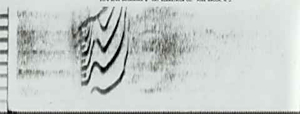Renn Lab Thesis Project
Monika Wieland
Wieland (2007) Repertoire Usage of the Southern Resident Community of Killer Whales (Orcinus orca).
The Southern Resident Community of killer whales (Orcinus orca) frequent the waters of Washington State and British Columbia. The three pods that make up the community (J-, K-, L-Pods) have been well studied since the 1970s. These long-lived marine mammals live in stable social groups and they are known for their complex communication system that involves a shared set of 26 discrete calls. Each pod has its own repertoire, or group-specific subset of the calls that are socially learned. While intensive acoustic studies occurred in the 1980s, much about discrete call function and repertoire structure remains unknown. Using recordings made on the west side of San Juan Island in the summers of 2005-2006, this study considers current repertoire usage of all three pods. Call type usage, frequency of call usage, two-call sequences, and mean call duration are analyzed for each pod and compared to 1978-1983 data to assess changes that have occurred in repertoire usage. Information theory and Zipf's statistic are also used to quantitatively compare the killer whale communication system to other species. Call types have been added and dropped from every pod's repertoire, demonstrating an unprecedented rate of change for killer whale communication systems. Other calls have changed in frequency of occurrence and many calls have increased in mean duration, perhaps as a result of increased vessel noise. Many two-call association are also found, indicating sequential structure in the repertoire. Analysis using Zipf's statistic also demonstrates a non-random repertoire structure. These observed changes all have implications for call function and overall repertoire complexity. These results demonstrate cultural evolution, complex repertoire structure, and potential impacts of anthropogenic noise. The increased understanding of killer whale discrete call system presented here will set the stage for future studies of this endangered population of killer whales.
This study set out with two main aims:
1) to compare current call usage to paset call usage
2) to assess the complexity and structure of the communication system.
Both aims were successfully met. Furthermore, comparison with past data
yielded details of many changes in killer whale discrete call usage.
TABLE 1 change in call usage for 3 pods
Call types used by each pod shifted and frequencies of call usage changed. This is evidence for cultural evolution occurring on a rapid time scale.
figure 11 duration or past and present calls
Durations of individual call types lengthened, possibly due to increased vessel noise.
transition matrix figure colored for each species.
This study has provided the first insights into more complex levels of Southern Resident discrete call repertoire structure such as two-call sequences.
Click HERE to see other Reed Biology Theses.
